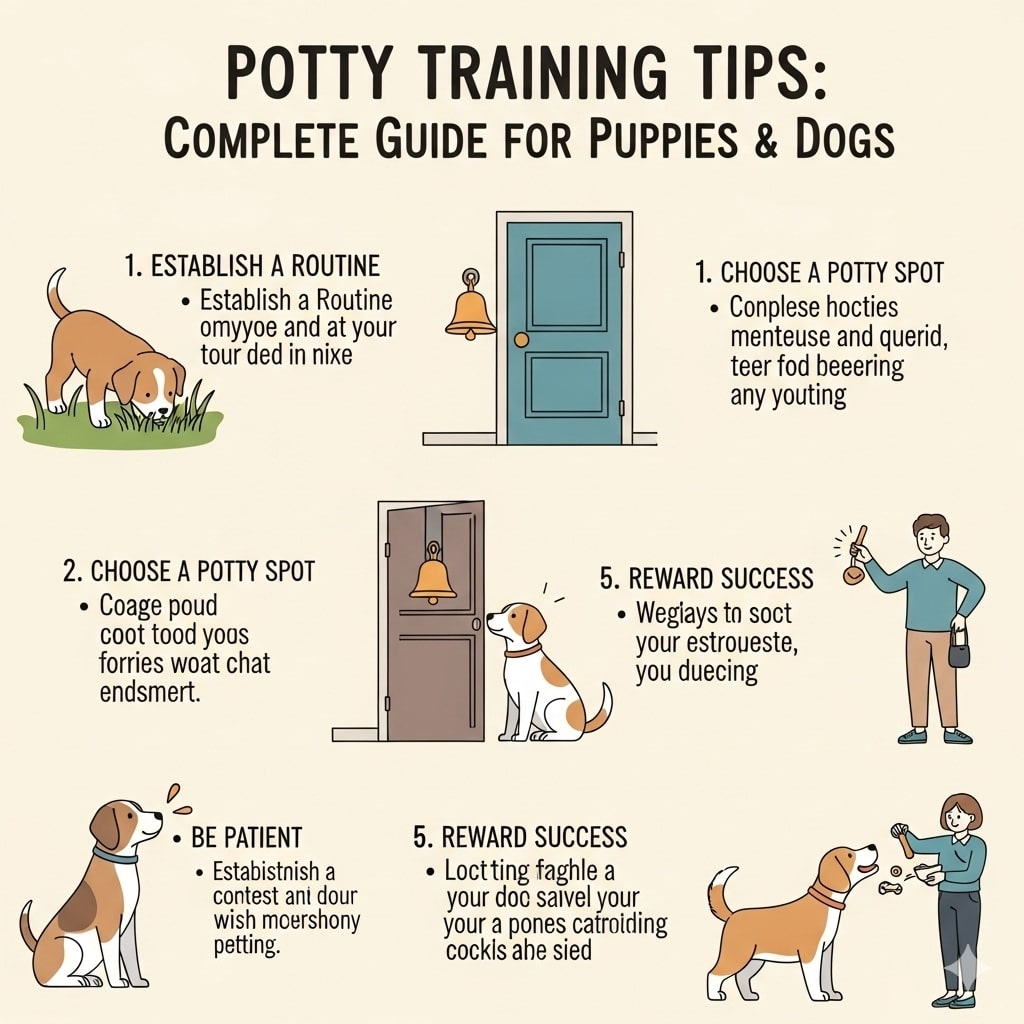“Step-by-Step Potty Training Tips for Puppies and Dogs: Easy, Effective, and Stress-Free Guide for US Pet Owners”
House training (also called potty training) is one of the most important parts of raising a puppy or adopting an adult dog. A well-trained dog makes life easier for the owner, creates a hygienic living environment, and ensures a stronger bond between pet and parent.
Many new pet owners feel overwhelmed by accidents in the house, but with patience, consistency, and the right strategies, you can successfully potty train your dog. This guide will cover step-by-step house training tips, common mistakes to avoid, breed-specific advice, and solutions for stubborn cases.
Discover more: Puppy Potty Training Tips: Complete Guide for New Owners

Discover More: Affordable Dog Grooming Tips for Busy US Pet Owners
Why House Training Is Important
- Hygiene: Prevents bad odors and keeps your home clean.
- Health: Reduces the risk of infections for both pets and humans.
- Behavior: Builds discipline and good manners in your dog.
- Bonding: A well-trained dog strengthens trust and companionship.
- Convenience: Saves time and frustration in the long run.
When to Start Potty Training
- Puppies: Start as early as 8 weeks old. Puppies have small bladders and need frequent potty breaks.
- Adult Dogs: Rescue or adopted dogs can also learn house training, but they may take longer depending on their past habits.
- Senior Dogs: Older dogs may need re-training if they develop incontinence issues.
How Long Does House Training Take?
- Puppies typically learn in 4–6 months with consistent training.
- Some dogs may take up to a year to be fully reliable.
- Factors influencing training time:
- Age
- Breed
- Consistency of schedule
- Owner’s patience and approach
Learn more: Best Dog Grooming Tips for Busy Pet Owners in the USA
Essential Tools for Potty Training
- Crate: Helps establish boundaries and prevents accidents.
- Puppy Pads: Useful for apartment living or when outdoor access is limited.
- Leash & Collar: For taking your puppy outside on a routine schedule.
- Cleaning Supplies: Enzyme-based cleaners to remove odors.
- Treats & Rewards: For positive reinforcement.
Step-by-Step House-Training Process
1. Set a Consistent Schedule
- Take your puppy out every 2–3 hours.
- Especially after:
- Waking up
- Eating or drinking
- Playtime
- Before bedtime
2. Choose a Potty Spot
- Always take your puppy to the same location outside.
- This helps them associate the smell with going potty.
3. Use Commands
- Use simple cues like “Go potty” or “Do your business”.
- Be consistent with the same phrase.
4. Reward Immediately
- Give treats and praise right after your dog eliminates outside.
- Avoid rewarding after coming back indoors—it confuses the puppy.
5. Monitor Indoor Time
- Supervise closely when indoors.
- If you see sniffing, circling, or whining—take your puppy outside immediately.
6. Crate Training Method
- Dogs naturally avoid soiling their sleeping space.
- Use a crate sized just large enough for comfort.
- Don’t leave your puppy in the crate for more than 3–4 hours (except at night).
7. Gradual Freedom
- Once your puppy consistently goes outside, give them more access to the house.
- Expand freedom slowly to prevent accidents.
Potty Training Puppies vs. Adult Dogs
Training Puppies
- Bladder control is weak.
- Needs frequent potty breaks.
- Positive reinforcement works best.
Training Adult Dogs
- May have old habits.
- Require patience and retraining.
- Rescue dogs may need confidence building.
Common Mistakes to Avoid
- Punishing Accidents – Scolding or rubbing a dog’s nose in mess causes fear.
- Inconsistent Schedule – Skipping potty breaks confuses the puppy.
- Not Cleaning Properly – Lingering odor encourages repeat accidents.
- Overusing Puppy Pads – Can cause dependence indoors.
- Lack of Patience – Training takes months, not days.
Nighttime Potty-Training Tips
- Limit water intake 2 hours before bed.
- Take your puppy out right before sleeping.
- Set an alarm for a midnight potty break during the first months.
- Gradually extend sleeping hours as bladder control improves.
Potty Training in Apartments
- Use balconies or pads as a temporary solution.
- Train your puppy to go outside whenever possible.
- Take your puppy out frequently since outdoor access is limited.
Solutions for Stubborn Dogs
- Increase potty breaks.
- Revisit crate training.
- Reward more consistently.
- Consult a veterinarian to rule out medical issues.
- Consider professional trainers if progress stalls.
Dealing with Accidents
- Stay calm—accidents are part of learning.
- Use enzyme cleaners to fully remove odor.
- Interrupt accidents with a firm “No” and immediately take your dog outside.
Potty Training by Breed
Some breeds are easier to train than others:
- Easier to train: Labrador Retrievers, Poodles, Border Collies.
- Stubborn breeds: Dachshunds, Basset Hounds, Bulldogs.
- Small breeds: Have smaller bladders—require more frequent trips.
Health Issues That Affect Potty Training
- Urinary tract infections (UTIs)
- Bladder stones
- Diabetes
- Incontinence in senior dogs
If accidents continue despite training, consult your vet.
Positive Reinforcement Techniques
- Use high-value treats (chicken, cheese, or store-bought training treats).
- Verbal praise and petting.
- Use clicker training for faster association.
- Never use punishment—it damages trust.
Travel & Potty Training
- Bring pads or portable potty systems during travel.
- Stick to your dog’s schedule as much as possible.
- Take breaks every 2–3 hours on road trips.
Advanced Training: Teaching to Ring a Bell
- Hang a bell on your door.
- Teach your dog to ring the bell when they want to go outside.
- Reinforces communication and prevents accidents.
Troubleshooting Checklist
If your dog isn’t progressing:
- Are you taking them out often enough?
- Are you rewarding immediately after success?
- Are accidents being cleaned properly?
- Is your crate size correct?
- Could there be a medical issue?
Frequently Asked Questions (FAQ)
Q1: How often should I take my puppy outside?
👉 Every 2–3 hours and after meals, naps, or playtime.
Q2: Should I use pee pads or go straight outdoors?
👉 Outdoors is best, but pads are useful for apartments.
Q3: What age is too late to potty train?
👉 It’s never too late, but older dogs may take longer.
Q4: Why does my puppy pee after coming inside?
👉 They may not have fully emptied their bladder—stay outside longer.
Q5: How do I stop marking behavior?
👉 Neutering, supervision, and reinforcing outdoor potty behavior help.
Conclusion
House training your puppy or adult dog requires consistency, patience, and positive reinforcement. With the right schedule, proper tools, and encouragement, your dog will learn to go potty in the right place.
Remember: accidents are normal, progress takes time, and every dog learns at their own pace. Follow these tips, avoid common mistakes, and soon you’ll enjoy a clean, stress-free home with a well-trained furry companion.
